Road Performance and Self-Healing Property of Bituminous Mixture Containing Urea–Formaldehyde Microcapsules
Abstract
:1. Introduction
2. Materials and Methods
2.1. Synthesis of Microcapsules
2.2. Fabrication of Bituminous Mixture Specimen
2.3. Wheel Tracking Test
2.4. Immersed Marshall Test
2.5. Freeze–Thaw Splitting Test
2.6. Low-Temperature Bending Test
2.7. Three-Point Bending Fatigue Test
2.8. Fatigue–Healing–Fatigue Test
3. Results and Discussion
3.1. High-Temperature Stability
3.2. Moisture Susceptibility
3.3. Thermal Crack Resistance
3.4. Anti-Fatigue Performance
3.5. Self-Healing Performance
3.5.1. Effect of the Damage Degree on Healing Rate
3.5.2. Effect of the Healing Duration on Healing Rate
3.5.3. Effect of the Healing Temperature on Healing Rate
4. Conclusions
- 1.
- The incorporation of UFMs enhancing the high-temperature rutting resistance of the bituminous mixture and yielding a 16.5% increase in DS.
- 2.
- Compared to the matrix bituminous mixture, the UFM bituminous mixture exhibited a 2.27% increase in MS0 and a 2.95% increase in TSR, indicating a slight improvement in moisture susceptibility.
- 3.
- UFM exhibited a negative effect on the thermal crack resistance of the bituminous mixture, with reductions in bending tensile strength and strain by 3.7% and 10.1%, respectively; however, it still met the specifications of China.
- 4.
- The fatigue life of the UFM bituminous mixture was higher than that of the matrix bituminous mixture at all stress levels, particularly at a stress ratio of 0.4; however, both were about equally sensitive to stress levels.
- 5.
- The introduction of 3 wt% UFMs significantly enhanced the self-healing ability of the matrix bituminous mixture, and the healing rate could increase by about 9% at most. Additionally, as the damage degree increased, the healing rate of bituminous mixtures with and without microcapsules noticeably decreased, while elevating the healing temperature and duration could enhance the healing rate.
Author Contributions
Funding
Institutional Review Board Statement
Informed Consent Statement
Data Availability Statement
Conflicts of Interest
References
- Andrea, R.; Osvaldo, M.; Aitor, R.; Diana, M.; Daniel Castro, F. UV curing study of semi-dense asphalt mixes with different sizes of copper slag—A sustainable rehabilitation and production strategy. Constr. Build. Mater. 2022, 347, 128621. [Google Scholar] [CrossRef]
- Eryk, M.; Piotr, M. Asphalt Mixtures Fatigue Life Considering Various Environmental Impacts. Materials 2023, 16, 966. [Google Scholar] [CrossRef]
- Mohammadreza, M.; Iman, A.; Reza, B. Evaluation of field aging effect on self-healing capability of asphalt mixtures. Constr. Build. Mater. 2023, 369, 130571. [Google Scholar] [CrossRef]
- Malinowski, S.; Woszuk, A.; Franus, W. Modern two-component modifiers inhibiting the aging process of road bitumen. Constr. Build. Mater. 2023, 409, 133838. [Google Scholar] [CrossRef]
- Pei, Z.; Xu, M.; Cao, J.; Feng, D.; Hu, W.; Ren, J.; Jing, R.; Yi, J. Analysis of the microcharacteristics of different kinds of asphalt based on different aging conditions. Mater. Struct. 2022, 55, 250. [Google Scholar] [CrossRef]
- Tauste, R.; Moreno-Navarro, F.; Sol-Sánchez, M.; Rubio-Gámez, M.C. Understanding the bitumen ageing phenomenon: A review. Constr. Build. Mater. 2018, 192, 593–609. [Google Scholar] [CrossRef]
- Gustavo, C.; Nuno Monteiro, A.; Rui, M. Impact of Rejuvenator-Modified Mastic on Asphalt Mixture Stiffness: Meso-Scale Discrete Element Method Approach. Buildings 2023, 13, 3023. [Google Scholar] [CrossRef]
- Ozge Erdogan, Y.; Mehmet, Y.; Erkut, Y.; Baha Vural, K.; Jose, N.; Alvaro, G. Self-healing of asphalt mastic using capsules containing waste oils. Constr. Build. Mater. 2021, 270, 121417. [Google Scholar] [CrossRef]
- Mohammad, K.; Ehsan Ahmadi, D.; Ali, B. Cracking features of asphalt mixtures under induced heating-healing. Constr. Build. Mater. 2022, 324, 126625. [Google Scholar] [CrossRef]
- Segundo, I.; Freitas, E.; Branco, V.; Landi, S.; Costa, M.; Carneiro, J. Review and analysis of advances in functionalized, smart, and multifunctional asphalt mixtures. Renew. Sust. Energ. Rev. 2021, 151, 111552. [Google Scholar] [CrossRef]
- Schuster, L.; de Melo, J.; Carpio, J. Effects of the associated incorporation of steel wool and carbon nanotube on the healing capacity and mechanical performance of an asphalt mixture. Int. J. Fatigue 2023, 168, 107440. [Google Scholar] [CrossRef]
- Mert, A.; Kursat, Y. Self-Healing Potential of Porous Asphalt Concrete Containing Different Aggregates and Metal Wastes Through Microwave Heating. J. Polytech. 2022, 25, 623–631. [Google Scholar] [CrossRef]
- Gallego, J.; Del, M.; Contreras, V.; Páez, A. Heating asphalt mixtures with microwaves to promote self-healing. Constr. Build. Mater. 2013, 42, 1–4. [Google Scholar] [CrossRef]
- Anupam, B.; Sahoo, U.; Chandrappa, A. A methodological review on self-healing asphalt pavements. Constr. Build. Mater. 2022, 321, 126395. [Google Scholar] [CrossRef]
- Gulisano, F.; Crucho, J.; Gallego, J.; Picado-Santos, L. Microwave healing performance of asphalt mixture containing electric arc furnace (EAF) slag and graphene nanoplatelets (GNPs). Appl. Sci. 2020, 10, 1428. [Google Scholar] [CrossRef]
- Amirhossien, K.; Mahyar, A.; Seyyed Mohammad, M. Effect of palm oil capsules on the self-healing properties of aged and unaged asphalt mixtures gained by resting period and microwave heating. Constr. Build. Mater. 2022, 316, 125901. [Google Scholar] [CrossRef]
- Li, Y.; Hao, P.; Li, N. Preparation and properties of a novel rejuvenator-loaded fiber for asphalt pavement. Constr. Build. Mater. 2022, 324, 126687. [Google Scholar] [CrossRef]
- Zaremotekhases, F.; Idris, I.; Hassan, M.; Mohammad, L.; Negulescu, I. Effect of sodium alginate fibers encapsulating rejuvenators on the self-healing capability and cracking resistance of asphalt mixtures. J. Mater. Civ. Eng. 2020, 32, 04020355. [Google Scholar] [CrossRef]
- Su, J.; Zhang, X.; Guo, Y.; Wang, X.; Li, F.; Fang, Y.; Ding, Z.; Han, N. Experimental observation of the vascular self-healing hollow fibers containing rejuvenator states in bitumen. Constr. Build. Mater. 2019, 201, 715–727. [Google Scholar] [CrossRef]
- Alpizar-Reyes, E.; Concha, J.; Martín-Martínez, F.; Norambuena-Contreras, J. Biobased spore microcapsules for asphalt self-healing. ACS Appl. Mater. Interfaces 2022, 14, 31296–31311. [Google Scholar] [CrossRef] [PubMed]
- Gonzalez-Torre, I.; Norambuena-Contreras, J. Recent advances on self-healing of bituminous materials by the action of encapsulated rejuvenators. Constr. Build. Mater. 2020, 258, 119568. [Google Scholar] [CrossRef]
- Abadeen, A.; Hussain, A.; Sathish, V.; Murali, G.; Vatin, N.; Riaz, H. Comprehensive Self-Healing Evaluation of Asphalt Concrete Containing Encapsulated Rejuvenator. Materials 2022, 15, 3672. [Google Scholar] [CrossRef] [PubMed]
- Garcia, A.; Austin, C.; Jelfs, J. Mechanical properties of asphalt mixture containing sunflower oil capsules. J. Clean Prod. 2016, 118, 124–132. [Google Scholar] [CrossRef]
- Jose, C.; Miguel, S.; Jose, N. Mechanical activation assisted of biobased encapsulated rejuvenators to promote asphalt self-healing. Mater. Today Commun. 2024, 38, 107735. [Google Scholar] [CrossRef]
- Christos, Z.; Ioannis, P.; Vasileia, L.; Dimitrios, K.; Antonis, K.; Stamatina, V. Self-healing coatings based on poly(urea-formaldehyde) microcapsules: In situ polymerization, capsule properties and application. Prog. Org. Coat. 2021, 161, 106475. [Google Scholar] [CrossRef]
- Wang, Y.; Wu, R.; Feng, M.; Zhang, G.; Zhang, C.; Hao, P. Synthesis of microcapsules with waste oil core and application in self-healing asphalt. Pet. Sci. Technol. 2020, 38, 203–209. [Google Scholar] [CrossRef]
- Al-Mansoori, T.; Micaelo, R.; Artamendi, I.; Norambuena-Contreras, J.; Garcia, A. Microcapsules for self-healing of asphalt mixture without compromising mechanical performance. Constr. Build. Mater. 2017, 155, 1091–1100. [Google Scholar] [CrossRef]
- Micaelo, R.; Freire, A.; Pereira, G. Asphalt self-healing with encapsulated rejuvenators: Effect of calcium-alginate capsules on stiffness, fatigue and rutting properties. Mater. Struct. 2020, 53, 1–17. [Google Scholar] [CrossRef]
- Zhang, L.; Hoff, I.; Zhang, X.; Yang, C. Investigation of the self-healing and rejuvenating properties of aged asphalt mixture containing multi-cavity Ca-alginate capsules. Constr. Build. Mater. 2022, 361, 129685. [Google Scholar] [CrossRef]
- Yao, X.; Xu, T. Fatigue fracture and self-healing behaviors of cold recycled emulsified asphalt mixture containing microcapsules based on semicircular bending test. J. Clean Prod. 2023, 410, 137171. [Google Scholar] [CrossRef]
- Shirzad, S.; Hassan, M.; Aguirre, M.; Mohammad, L.; Daly, W. Evaluation of sunflower oil as a rejuvenator and its microencapsulation as a healing agent. J. Mater. Civ. Eng. 2016, 28, 04016116. [Google Scholar] [CrossRef]
- Katoueizadeh, E.; Zebarjad, S.; Janghorban, K. Investigating the effect of synthesis conditions on the formation of urea–formaldehyde microcapsules. J. Mater. Res. Technol.-JMRT 2019, 8, 541–552. [Google Scholar] [CrossRef]
- Li, R.; Zhou, T.; Pei, J. Design, preparation and properties of microcapsules containing rejuvenator for asphalt. Constr. Build. Mater. 2015, 99, 143–149. [Google Scholar] [CrossRef]
- Kosarli, M.; Bekas, D.; Tsirka, K.; Baltzis, D.; Vaimakis-Tsogkas, D.; Orfanidis, S.; Papavassiliou, G.; Paipetis, A. Microcapsule-based self-healing materials: Healing efficiency and toughness reduction vs. capsule size. Compos. Pt. B Eng. 2019, 171, 78–86. [Google Scholar] [CrossRef]
- Li, J.; Yang, S.; Muhammad, Y.; Sahibzada, M.; Zhu, Z.; Liu, T.; Liao, S. Fabrication and application of polyurea formaldehyde-bioasphalt microcapsules as a secondary modifier for the preparation of high self-healing rate SBS modified asphalt. Constr. Build. Mater. 2020, 246, 118452. [Google Scholar] [CrossRef]
- Aguirre, M.; Hassan, M.; Shirzad, S.; Mohammad, L.; Cooper, S.; Negulescu, I. Laboratory testing of self-healing microcapsules in asphalt mixtures prepared with recycled asphalt shingles. J. Mater. Civ. Eng. 2017, 29, 04017099. [Google Scholar] [CrossRef]
- Zhang, H.; Bai, Y.; Cheng, F. Rheological and self-healing properties of asphalt binder containing microcapsules. Constr. Build. Mater. 2018, 187, 138–148. [Google Scholar] [CrossRef]
- Huang, J.; Muhammad, Y.; Li, J.; Li, J.; Yang, C. Study on the self-healing performance of urea-formaldehyde–dicyclopentadiene (UF–DCPD) microcapsules-incorporated SBS polymer-modified asphalt. Arab. J. Sci. Eng. 2022, 1–13. [Google Scholar] [CrossRef]
- Chung, K.; Lee, S.; Park, M.; Yoo, P.; Hong, Y. Preparation and characterization of microcapsule-containing self-healing asphalt. J. Ind. Eng. Chem. 2015, 29, 330–337. [Google Scholar] [CrossRef]
- Wang, X.; Guo, G.; Zou, F.; Zhao, H.; Li, Y. Enhancing self-healing properties of microcrack on aged asphalt incorporating with microcapsules encapsulating rejuvenator. Constr. Build. Mater. 2022, 344, 128123. [Google Scholar] [CrossRef]
- ISO 12697-22; Bituminous Mixtures—Test Methods—Part 22: Wheel Tracking. International Organization for Standardization: Geneva, Switzerland, 2020.
- ASTM D6927-15; Standard Test Method for Marshall Stability and Flow of Bituminous Mixtures. ASTM International: West Conshohocken, PA, USA, 2015.
- AASHTO 2003. Standard Method of Test for Resistance of Compacted Asp-Halt Mixture to Moisture-Induced Damage. American Association of State Highway and Transportation Officials: Washington, DC, USA, 2003.
- ASTM D790-17; Standard Test Methods for Flexural Properties of Unreinforced and Reinforced Plastics and Electrical Insulating Materials. ASTM International: Washington, DC, USA, 2017.
- ASTM D7460-10; Standard Test Method for Determining Fatigue Failure of Compacted Bitumen Concrete Subjected to Repeated Flexural Bending. ASTM International: West Conshohocken, PA, USA, 2010.
- Zhang, H. Self-healing property and road performance of asphalt binder and asphalt mixture containing urea-formaldehyde microcapsule. In Eco-Efficient Pavement Construction Materials; Woodhead Publishing: Sawston, UK, 2020; pp. 171–196. [Google Scholar] [CrossRef]
- Grangeiro, A.; Figueirêdo, D.; García, Á. Addition of encapsulated soybean oil and waste cooking oil in asphalt mixtures: Effects on mechanical properties and self-healing of fatigue damage. J. Mater. Civ. Eng. 2022, 34, 04022002. [Google Scholar] [CrossRef]
- Norambuena-Contreras, J.; Yalcin, E.; Hudson-Griffiths, R.; García, A. Mechanical and self-healing properties of stone mastic asphalt containing encapsulated rejuvenators. J. Mater. Civ. Eng. 2019, 31, 04019052. [Google Scholar] [CrossRef]
- Li, Y.; Hao, P.; Zhang, M.; Sun, B.; Liu, J.; Li, N. Synthesis and characterization of calcium alginate capsules encapsulating soybean oil for in situ rejuvenation of aged asphalt. J. Mater. Civ. Eng. 2021, 33, 04021310. [Google Scholar] [CrossRef]
- Zhang, H.; Zhang, Z.; Lv, J.; Zhang, G. Effect of Lithium Silicate–Impregnated Limestone Aggregate on Skid Resistance Properties of Bituminous Mixture. J. Mater. Civ. Eng. 2022, 34, 04022251. [Google Scholar] [CrossRef]
- Liang, B.; Lan, F.; Shi, K.; Qian, G.; Liu, Z.; Zheng, J. Review on the self-healing of bitumen materials: Mechanism, affecting factors, assessments and improvements. Constr. Build. Mater. 2021, 266, 120453. [Google Scholar] [CrossRef]
- Chen, Y.; Ji, X.; Si, B.; Zhang, Z.; Shao, D.; Zhu, S.; He, S. Investigation on self-healing performance of asphalt mixture containing microcapsules and survival behaviour of microcapsules. Int. J. Pavement Eng. 2023, 24, 2165657. [Google Scholar] [CrossRef]

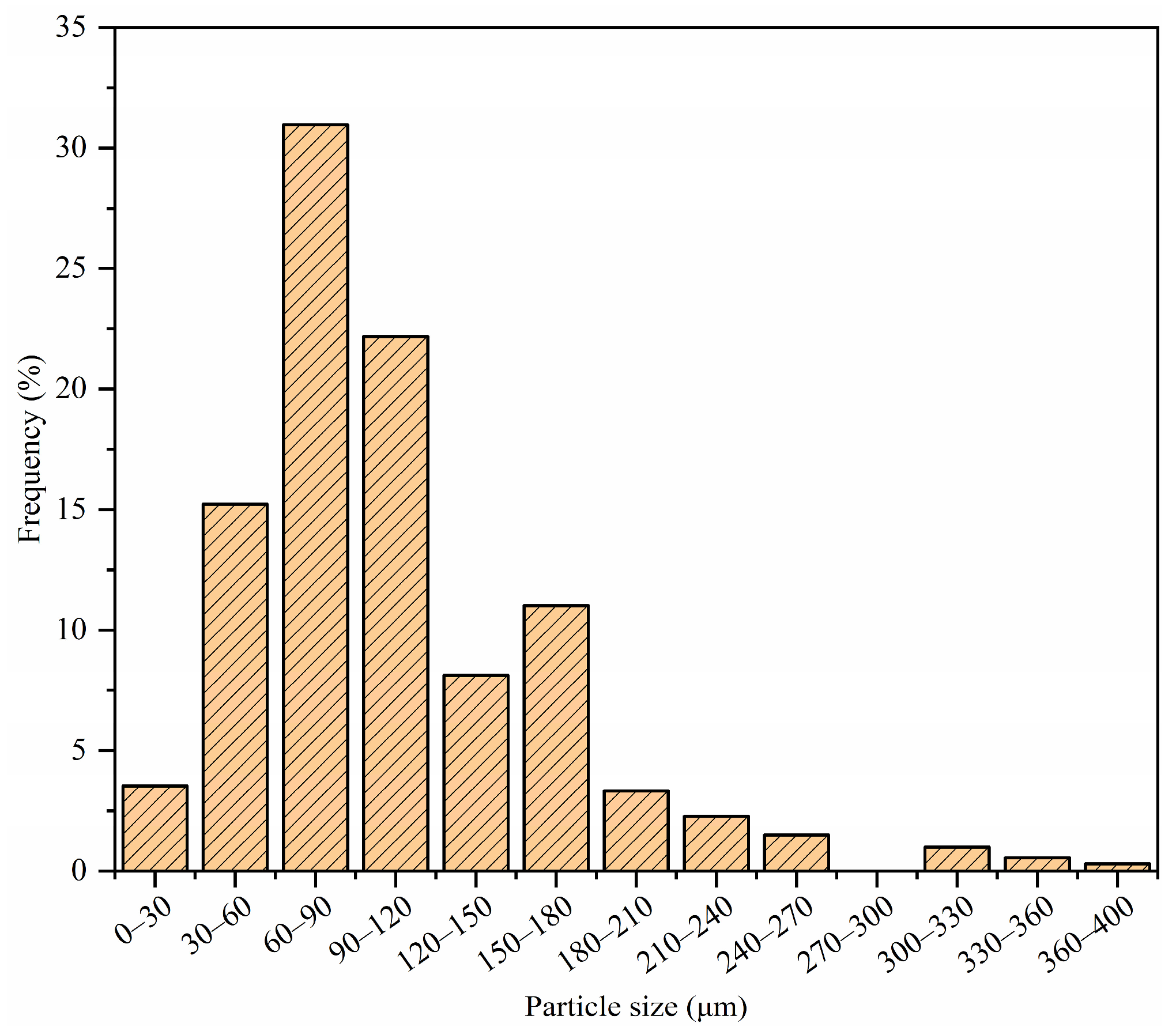
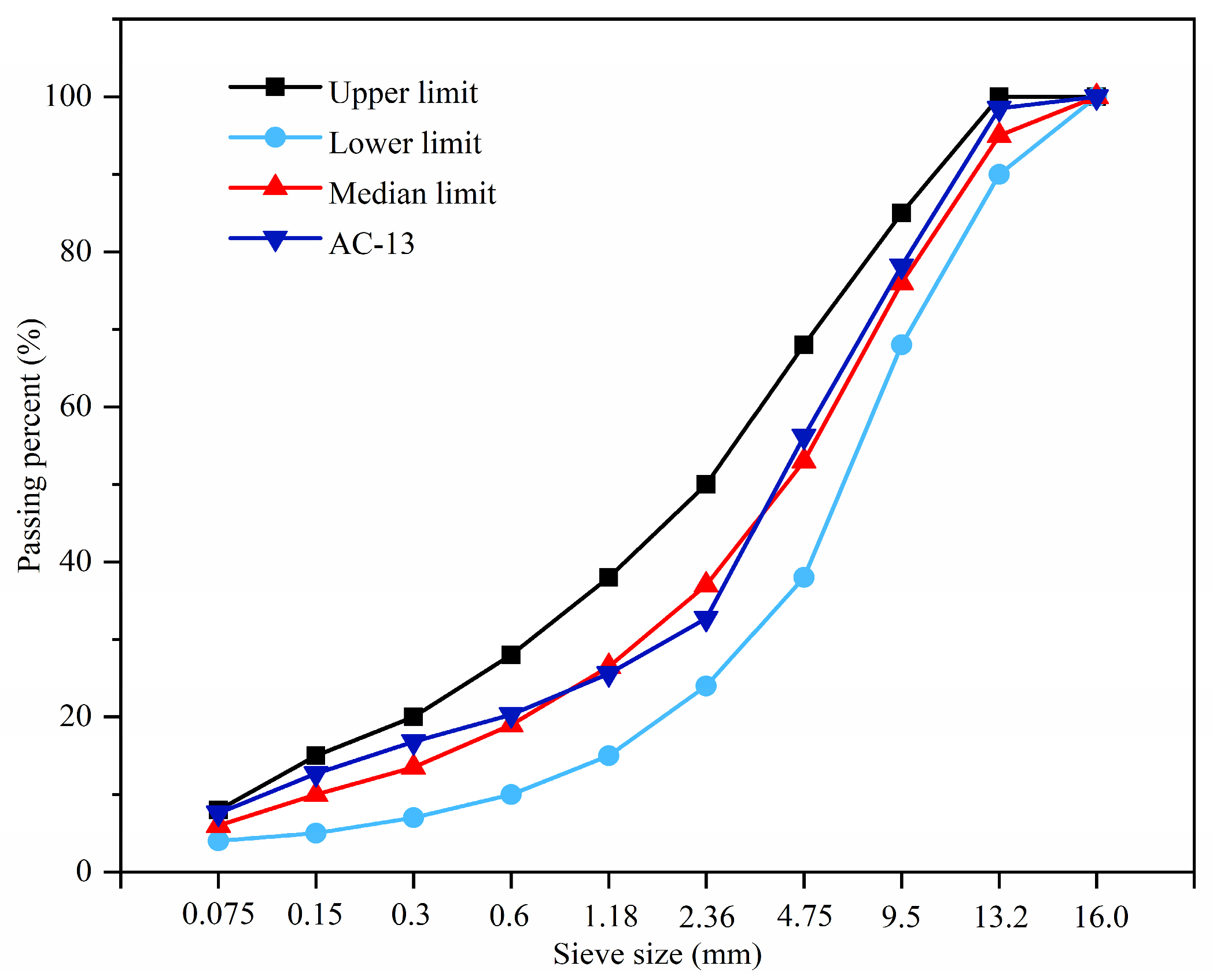

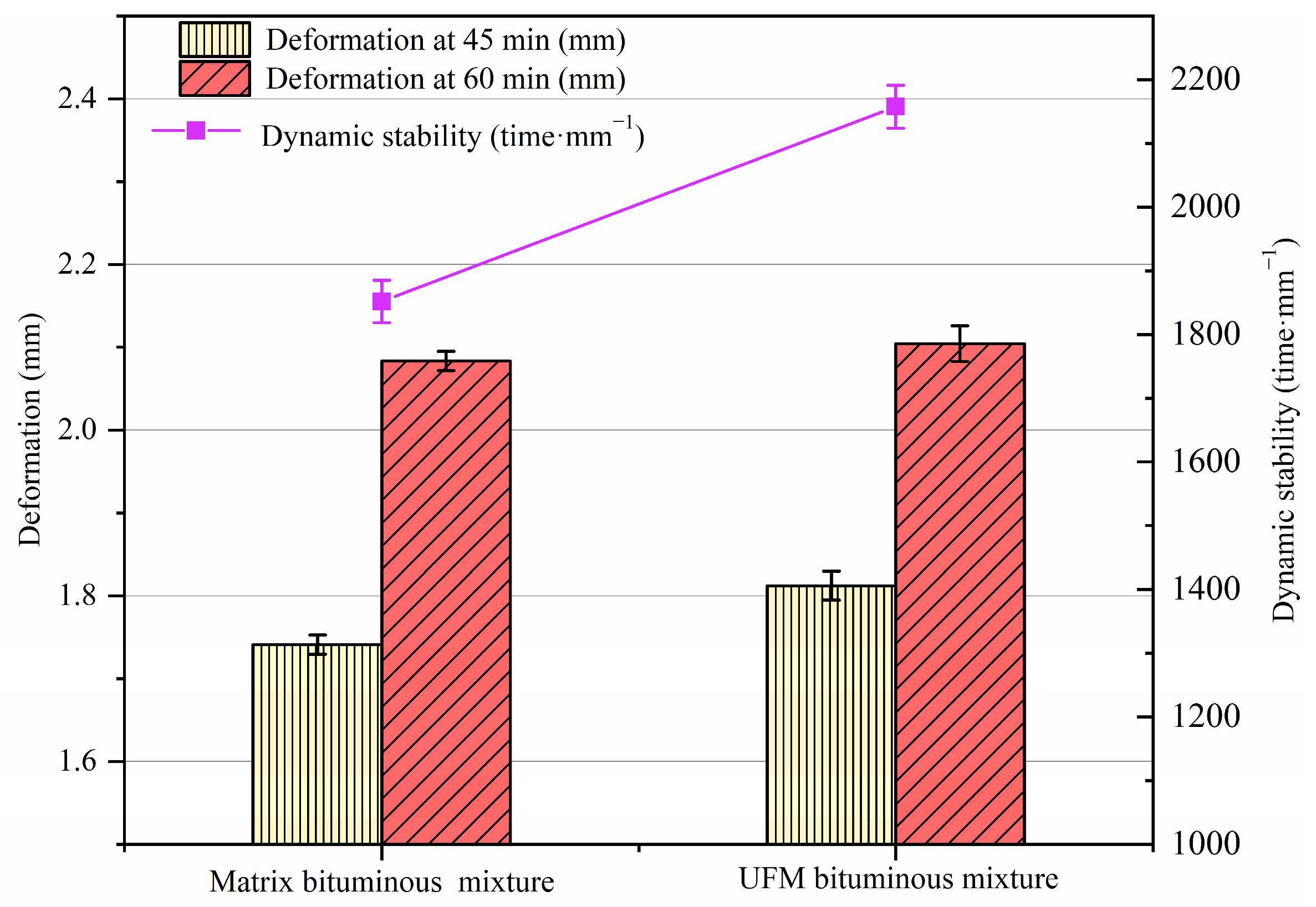

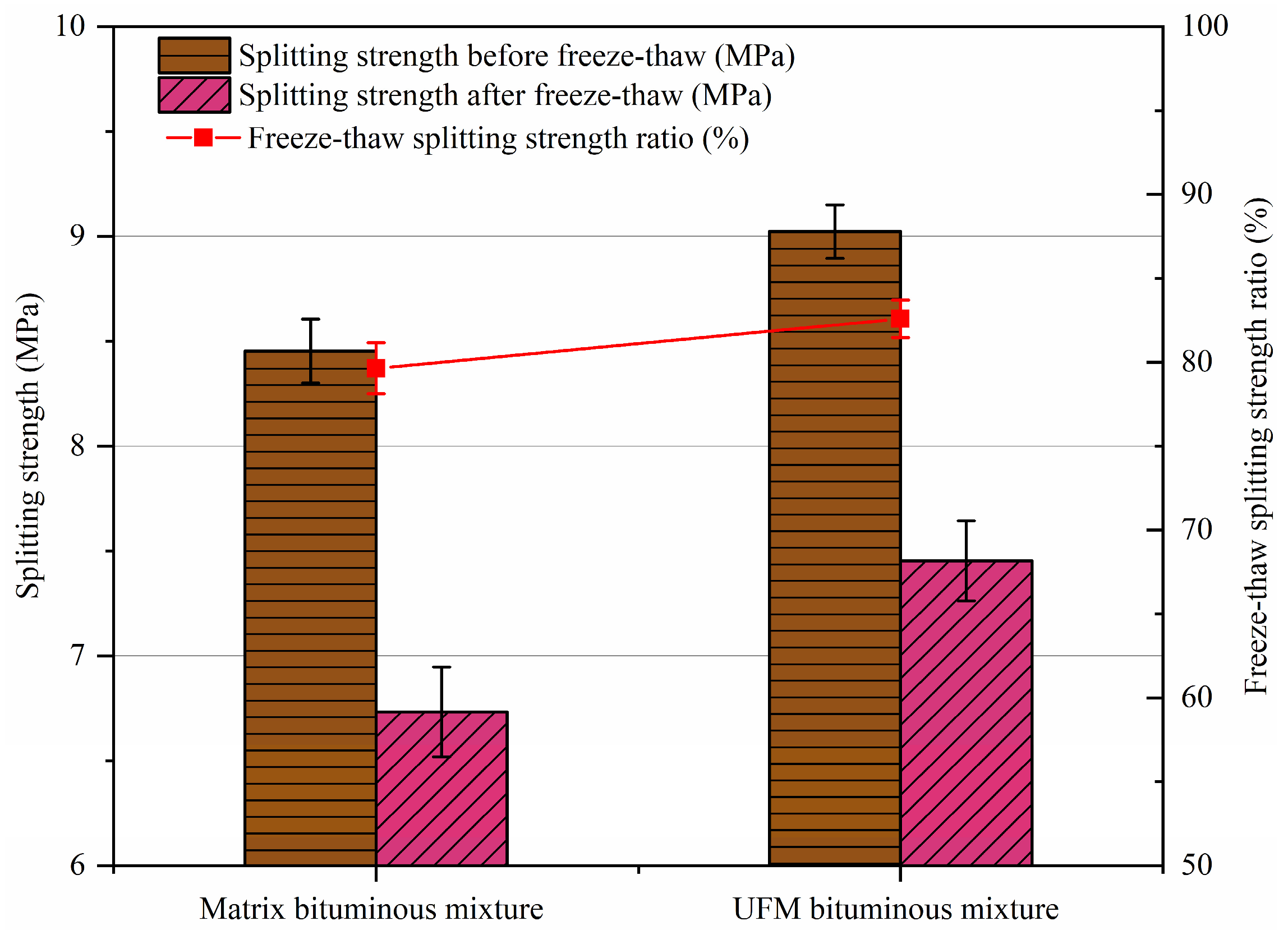
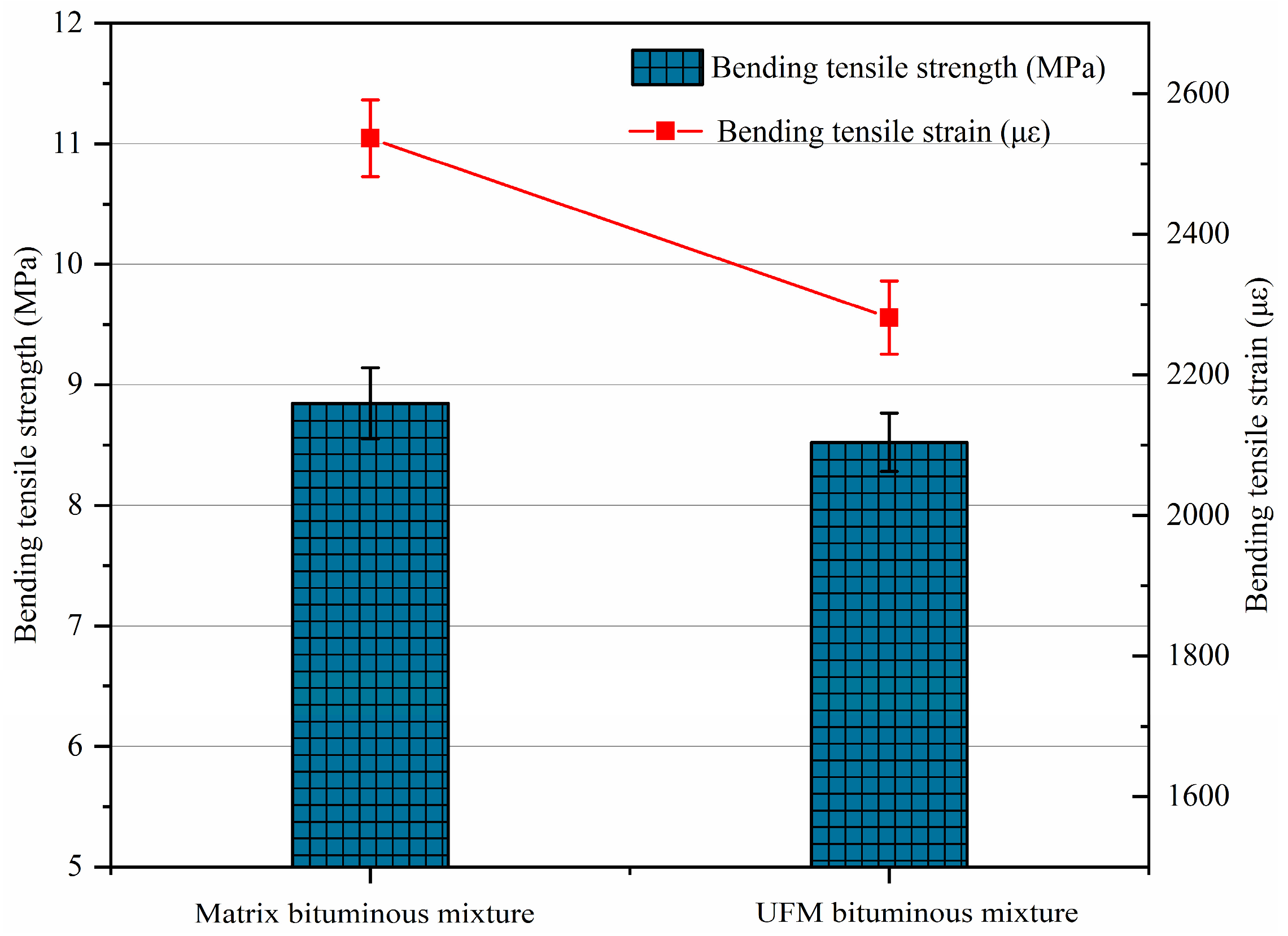
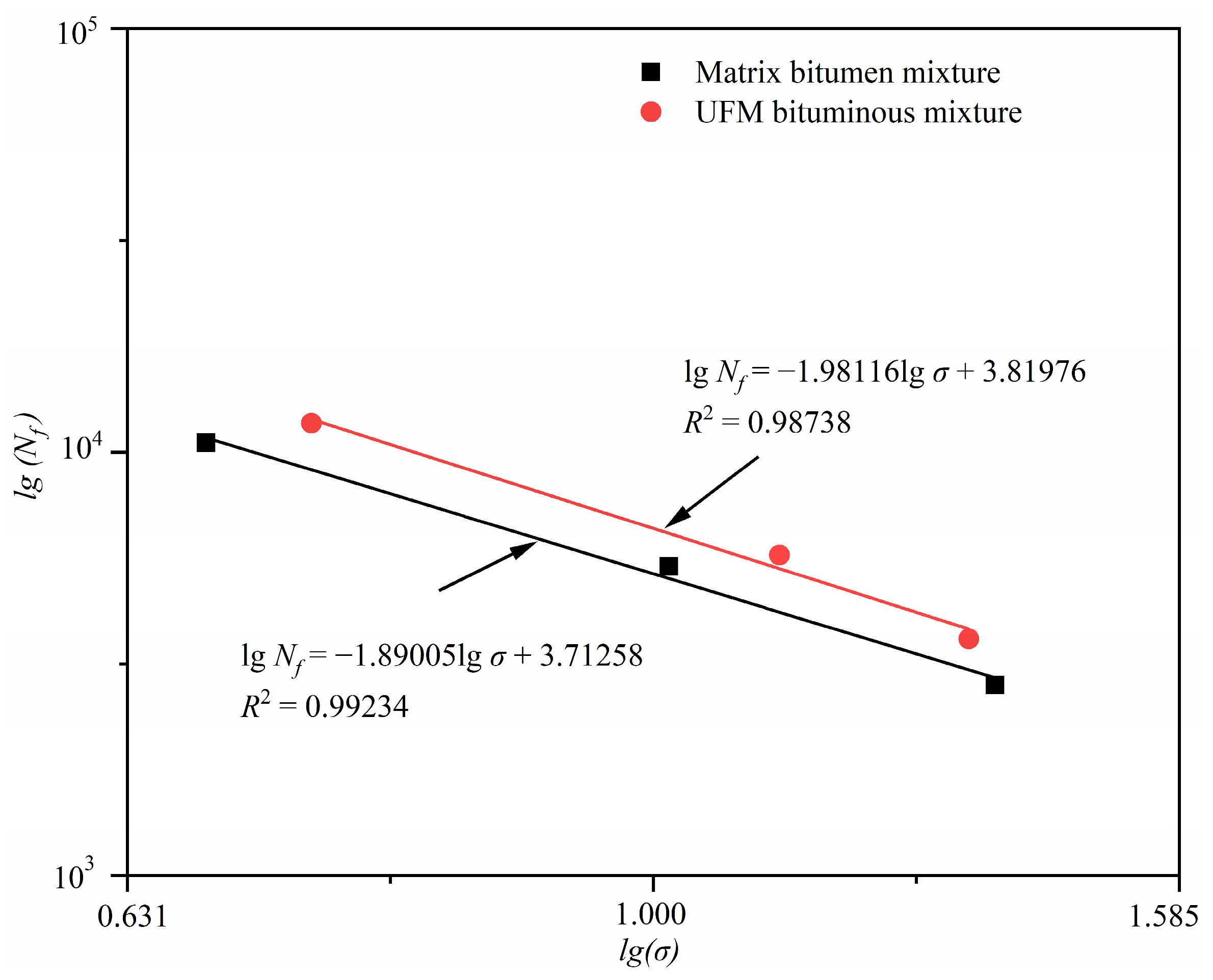
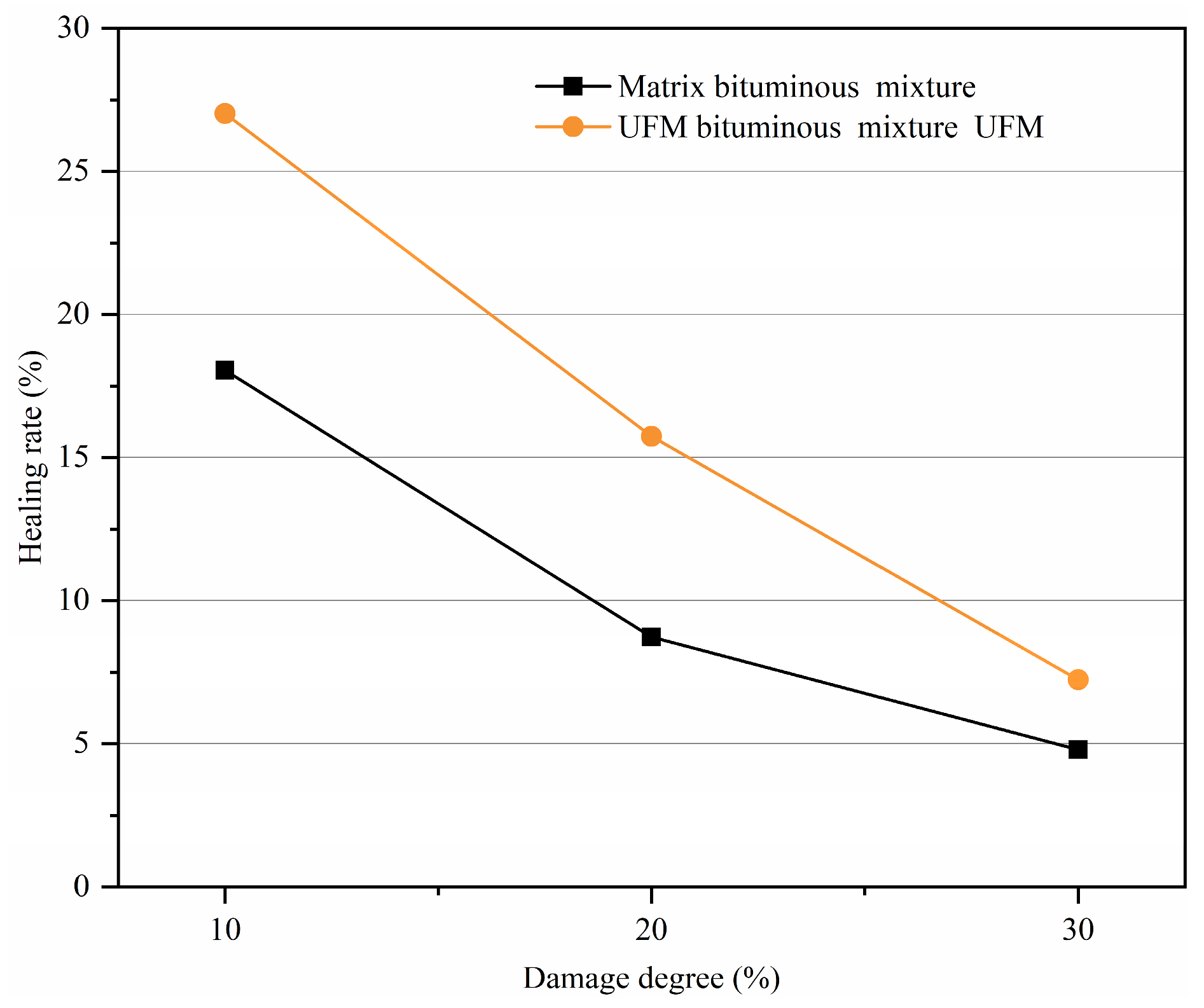
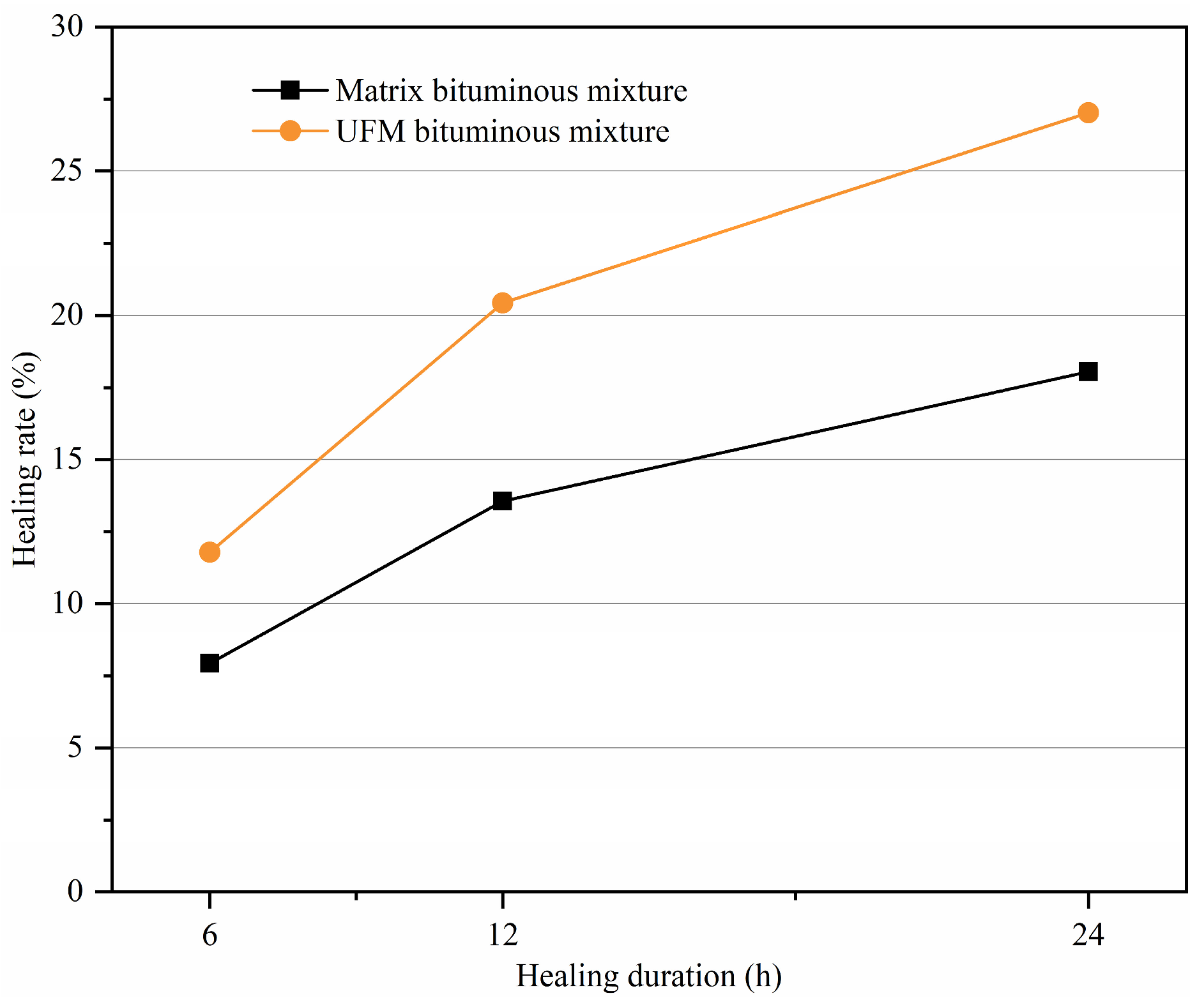
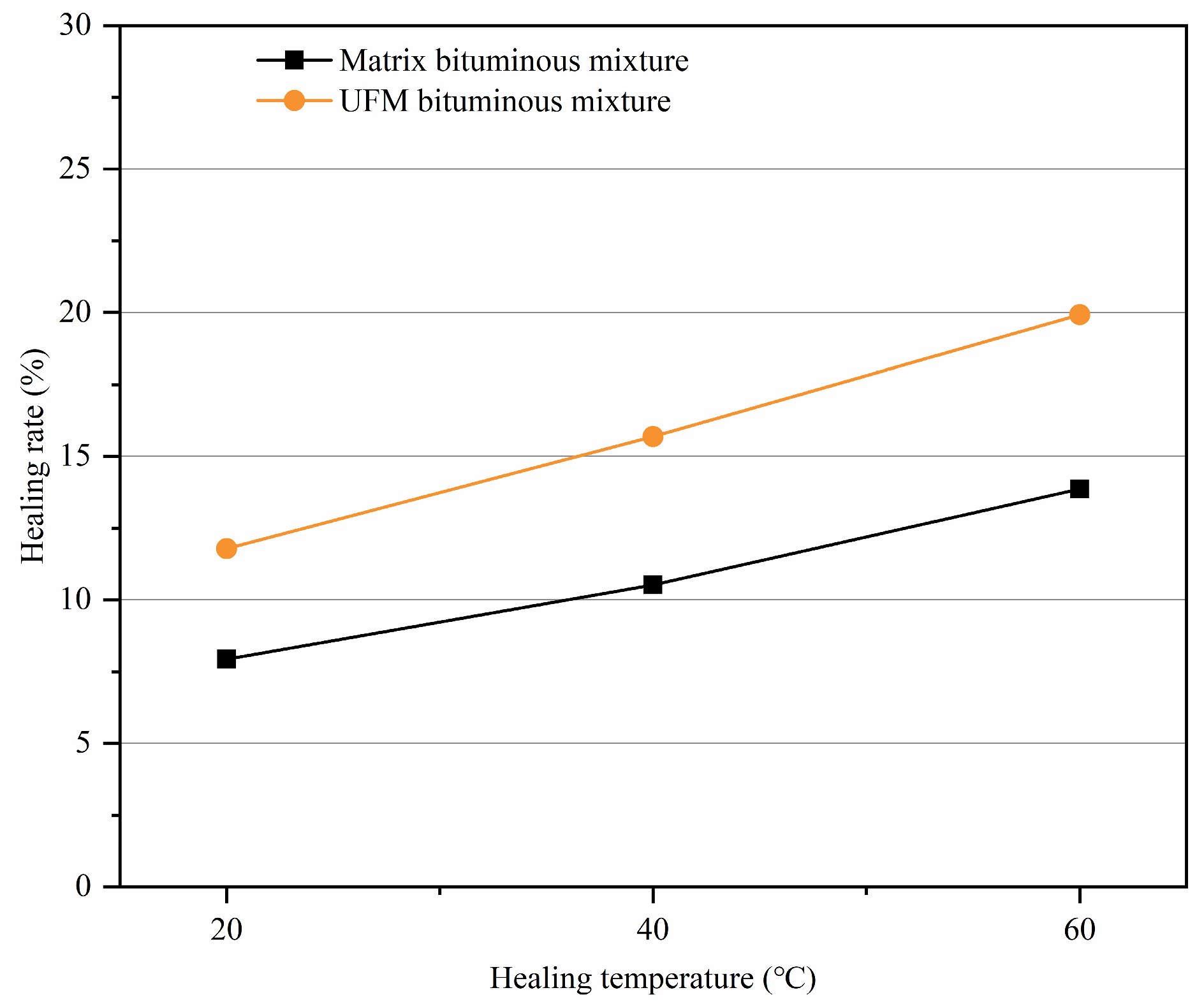
| Properties | Results | Standard Requirements | |
|---|---|---|---|
| Apparent relative density | 9.5–16 mm | 2.923 | ≥2.60 |
| 4.75–9.5 mm | 2.926 | ||
| 2.36–4.75 mm | 2.896 | ||
| Water Absorption (%) | 9.5–16 mm | 0.5 | ≤2.0 |
| 4.75–9.5 mm | 0.64 | ||
| 2.36–4.75 mm | 0.53 | ||
| Crushing value (%) | 11.8 | ≤26 | |
| Polish stone value (PSV) | 43 | ≥42 | |
| Soft rock content (%) | 0.71 | ≤3 | |
| Los Angeles abrasion loss (%) | 10.6 | ≤28 | |
| Properties | Results | Standard Requirements |
|---|---|---|
| Apparent relative density | 2.679 | ≥2.50 |
| Sand equivalent (%) | 64 | ≥60 |
| Angularity (S) | 42.7 | ≥30 |
| Mud content (<0.075 mm) (%) | 2.1 | ≤ 3 |
| Properties | Results | Standard Requirements | |
|---|---|---|---|
| Apparent relative density | 2.761 | ≥2.50 | |
| Water content (%) | 0.4 | ≤1 | |
| Particle size range (%) | <0.6 mm | 100 | 100 |
| <0.15 mm | 92.9 | 90~100 | |
| <0.075 mm | 81.8 | 75~100 | |
| Hydrophilic coefficient | 0.70 | <1 | |
| Bitumen | Matrix Bitumen | Bitumen Containing 3 wt% Microcapsules |
|---|---|---|
| Penetration (25 °C, 100 g, 5 s) (0.1 mm) | 90.8 | 73.3 |
| Softening point (°C) | 47.3 | 52.4 |
| Ductility (50 mm/min, 10 °C) (cm) | 43.8 | 26.5 |
| Types | Matrix Bituminous Mixture | UFM Bituminous Mixture |
|---|---|---|
| Failure stress (MPa) | 3.38 | 3.72 |
| Types | Stress Ratio | Stress, σ (MPa) | lg (σ) | Mean of Fatigue Life, Nf (Number of Times) | lg (Nf) |
|---|---|---|---|---|---|
| Matrix bituminous mixture | 0.2 | 0.676 | −0.17 | 10,524 | 4.022 |
| 0.3 | 1.014 | 0.006 | 5465 | 3.73 | |
| 0.4 | 1.352 | 0.13 | 2847 | 3.45 | |
| UFM bituminous mixture | 0.2 | 0.744 | −0.13 | 11,697 | 4.068 |
| 0.3 | 1.116 | 0.048 | 5709 | 3.757 | |
| 0.4 | 1.336 | 0.12 | 3627 | 3.559 |
Disclaimer/Publisher’s Note: The statements, opinions and data contained in all publications are solely those of the individual author(s) and contributor(s) and not of MDPI and/or the editor(s). MDPI and/or the editor(s) disclaim responsibility for any injury to people or property resulting from any ideas, methods, instructions or products referred to in the content. |
© 2024 by the authors. Licensee MDPI, Basel, Switzerland. This article is an open access article distributed under the terms and conditions of the Creative Commons Attribution (CC BY) license (https://creativecommons.org/licenses/by/4.0/).
Share and Cite
Zhang, H.; Yao, T.; Cheng, F. Road Performance and Self-Healing Property of Bituminous Mixture Containing Urea–Formaldehyde Microcapsules. Materials 2024, 17, 943. https://doi.org/10.3390/ma17040943
Zhang H, Yao T, Cheng F. Road Performance and Self-Healing Property of Bituminous Mixture Containing Urea–Formaldehyde Microcapsules. Materials. 2024; 17(4):943. https://doi.org/10.3390/ma17040943
Chicago/Turabian StyleZhang, Hongliang, Tong Yao, and Fenglei Cheng. 2024. "Road Performance and Self-Healing Property of Bituminous Mixture Containing Urea–Formaldehyde Microcapsules" Materials 17, no. 4: 943. https://doi.org/10.3390/ma17040943
APA StyleZhang, H., Yao, T., & Cheng, F. (2024). Road Performance and Self-Healing Property of Bituminous Mixture Containing Urea–Formaldehyde Microcapsules. Materials, 17(4), 943. https://doi.org/10.3390/ma17040943






